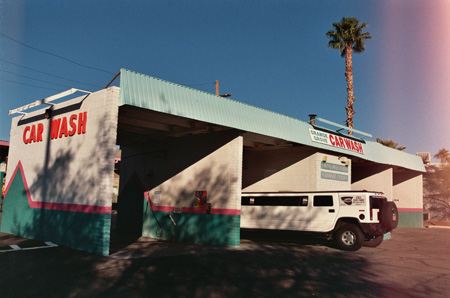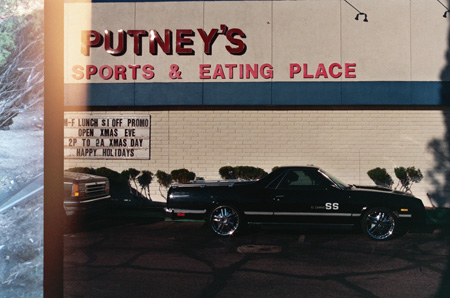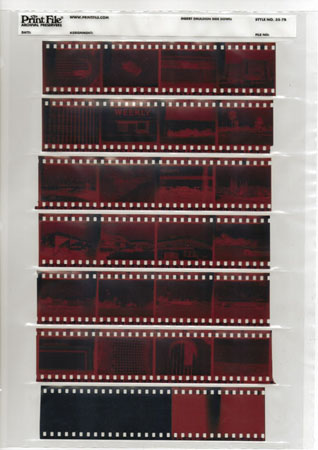| Author |
Message |
    
Alexmayer
Tinkerer
Username: Alexmayer
Post Number: 2
Registered: 12-2011
Rating: N/A
Votes: 0 (Vote!) | | Posted on Tuesday, December 20, 2011 - 03:42 pm: | 





|
I recently purchased a Ricoh KR-10 Super that had trashed seals but otherwise looked immaculate. I replaced all the gummy seals with a Ricoh and friends seal kit from Jon, unfortunately because the kit has to cover such a wide assortment of cameras the latch seal wasn't as long or as thick as the original. While I waited for a replacement to arrive from Jon, I shot a roll through the camera as the original latch seal was in decent enough shape.
After receiving these negatives back from Walgreens, I got a couple light leaks, with only one serious one, all in the upper right corner of the frames. (If the negatives are viewed emulsion side down and image oriented upright.)



I figured this would be resolved with the replacement latch seal from Jon, and I ran another role through after installing it. Unfortunately over half of the negatives in this role (developed at Target) had much denser leaks in the same location.



Shots 2-16 were all shot in an hour in full sun. After a few days 17-25 were shot in an hour under cloudy conditions. Once again the body's a Ricoh KR-10 Super, the cassette loads nub down, all shots were taken with a Tokina SD 28-70mm f 3.5-4.5 – the focusing barrel is loose and wiggles slightly – and the camera has an electronically-controlled, vertical focal plane shutter.
Any hunches on the source based on these conditions or general information on locating sources of leaks depending on their location or representation on a negative is appreciated.
Larger and additional examples can be seen in this set: http://www.flickr.com/photos/alexrmayer/sets/72157628503260075/
All scans are originals from Target and Walgreens. |
    
Mr_flibble
Tinkerer
Username: Mr_flibble
Post Number: 42
Registered: 10-2011
Rating: N/A
Votes: 0 (Vote!) | | Posted on Wednesday, December 21, 2011 - 02:00 am: | 





|
I'd say the leak is coming from the bottom side of the camera, possibly at the door latch or the hinge.
The purplish sheen would indicate light falling on the back of the film.
A bright white leak would indicate light falling on the emulsion side. |
    
Donnie_strickland
Tinkerer
Username: Donnie_strickland
Post Number: 140
Registered: 09-2006
Rating: N/A
Votes: 0 (Vote!) | | Posted on Wednesday, December 21, 2011 - 06:43 am: | 





|
It's definitely coming from the bottom of the camera. Check that hinge seal again...sometimes on these Ricoh models it can be a little tricky. I've had to redo a couple of mine. I find that the felt type of seals work better here than the foam type.
I love Jon's kits too, btw! |
    
Rick_oleson
Tinkerer
Username: Rick_oleson
Post Number: 1158
Registered: 07-2006
Rating: N/A
Votes: 0 (Vote!) | | Posted on Wednesday, December 21, 2011 - 05:20 pm: | 





|
the hinge seal is more commonly a problem than the latch seal, just because there's a cassette next to the latch and there's bare film just inside the hinge.
To really pinpoint it though, here's what you do: Load a fresh roll of cheap film; with the lens cap on, wind and release up to about frame 5 or 6. Now go for a long walk in the sunshine. Maybe fire a strobe at the camera from various angles, whatever you like to give it a good light bath. Now, make ONE exposure of a clear subject on that frame. DO NOT ADVANCE THE FILM.
Go back indoors, rewind and remove the film, and have it developed. Place the negative strip back into the camera, with the exposed frame upside down in the negative gate, emulsion forward. Now, inspect the film for leak spots. The location of these spots on the film will now correspond exactly to the location of the leaks in the camera. |
    
Alexmayer
Tinkerer
Username: Alexmayer
Post Number: 3
Registered: 12-2011
Rating: N/A
Votes: 0 (Vote!) | | Posted on Saturday, December 24, 2011 - 11:40 am: | 





|
After poking around the body with a flashlight, I think the leak must occur while the film is spooling up, and closer inspection of the hinge seal revealed some weak points.
Notches in the end of the top and bottom back channel rails create square holes between the door hinges and the new hinge seal that run right through the back and under the hinge. There appears to be some old seal material plugging the top square, but the alcohol completely cleaned out the bottom one which I'm guessing resulted in the leak on the film. The red square shows the location of the square hole on the bottom.

While I was looking around the seal there's also a gap between the outside of the hinge and the leatherette which the felt seal wasn't deep enough to fill. I guess I could just stuff some foam bits into this outside gap and the square holes, but I'd rather just do it right and cut a piece of felt to fill the entire area.
Does it make sense that the bottom square hole could cause the leaks on the above images? If so, does anyone know how to get the back door off a 35mm SLR so I can more accurately measure and place a new seal?
The above image will be available at a larger size in the flickr set mentioned earlier. |
    
Donnie_strickland
Tinkerer
Username: Donnie_strickland
Post Number: 141
Registered: 09-2006
Rating: N/A
Votes: 0 (Vote!) | | Posted on Saturday, December 24, 2011 - 01:34 pm: | 





|
Yes, that area inside the red square must be covered.
Isn't the door removable? On most Ricohs of that type you simply press down on the tiny screw head which is visible after the door is open --it's located on the hinge pin. The pin is spring-loaded, and out she comes. This system was used to make it easy to replace the back door with the optional Ricoh Data Back.
When I replace the door seals on one of these Ricohs, I just remove the door altogether. |
    
Alexmayer
Tinkerer
Username: Alexmayer
Post Number: 4
Registered: 12-2011
Rating: N/A
Votes: 0 (Vote!) | | Posted on Saturday, December 24, 2011 - 01:46 pm: | 





|
I figured it had to do with that screw. I'll change out the seals and post the negatives from my next roll.
Thanks for all the help. |